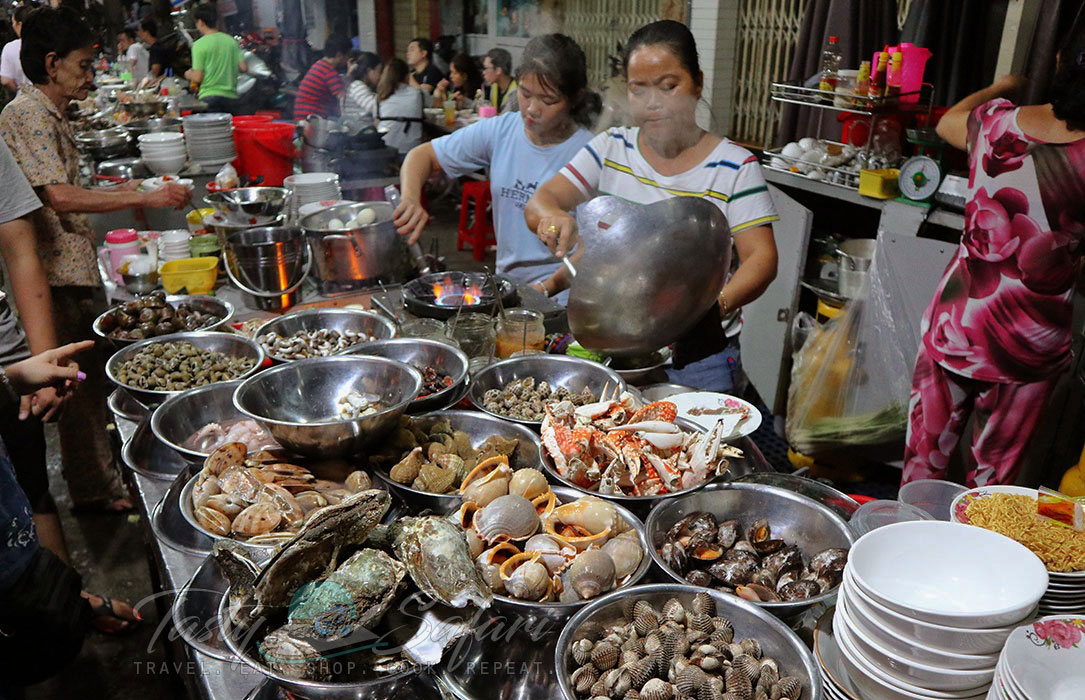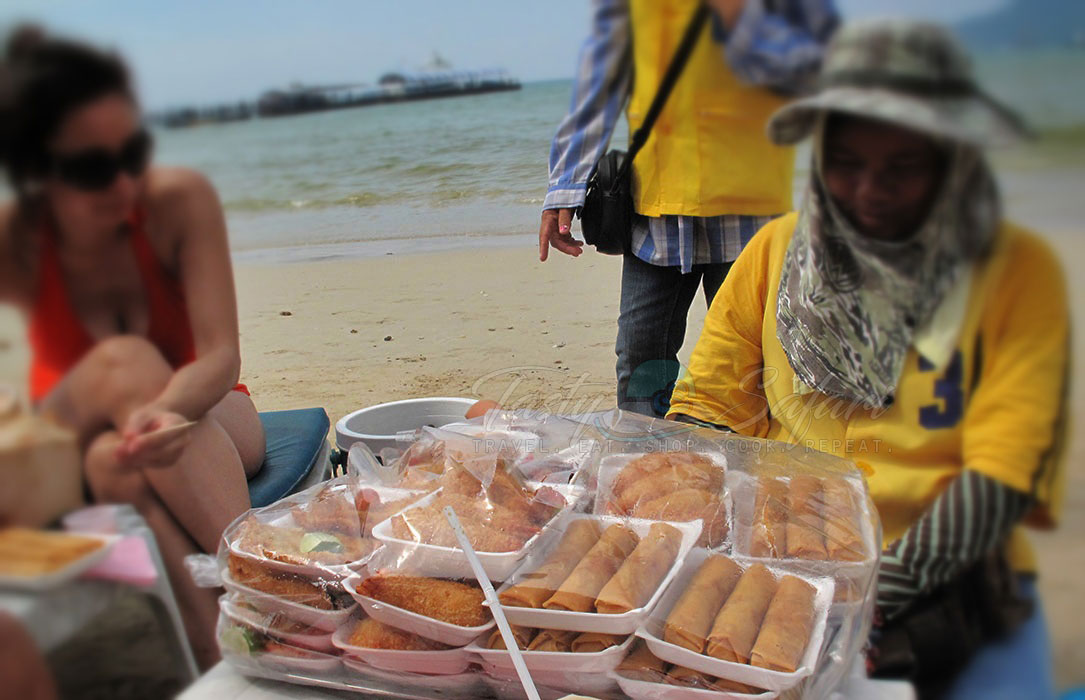Not too long ago, street food was defined as cheap ready-to-eat food or drink sold by a hawker on the street. Asian street food today has expanded that definition by leaps and bounds.

Sometime after 9.00 o’clock on a Friday evening, on a narrow street that only foot pedestrians and the occasional motorbike could navigate, long tables were laid out. Oversized stainless steel bowls were overflowing with every imaginable variety of shellfish. Oysters as large as my hand. Clams. Scallops. Crabs. Even snails.
They weren’t for sale — not market style anyway. Customers chose what fresh ingredients they fancied and their choices were cooked in woks. While waiting for their food, customers sat on squat plastic stools arranged around small folding tables. When the dishes were done, the vendors brought the food to the customers in plates or bowls. Disposable chopsticks (or plastic cutlery for those who don’t know how to eat with chopsticks) were provided. So were sealed wet wipes. And, more often than not, complimentary tea.

It’s Saigon in 2019 where street food is legendary. And, these days, street food in Saigon is no longer limited to pre-cooked food that are simply packed and handed to customers. In parts of Asia where tourists come in hordes to sample the street food, there may be cooking involved. And the cooking is not always limited to simple charcoal grilling. In many cases, street food is cooked right on the street as though the cooking is being done in a family kitchen.

What exactly is street food? To define street food, we need to understand its origin and its evolution.
Where did “street food” originate?
According to World Chefs, street food is as old as ancient civilizations. Ancient Greece. Ancient China. Ancient Egypt.
“In the excavations at Herculaneum and Pompei, the well-preserved remains of the typical “thermopolia” can be seen, forerunners of today’s food stalls. These were a kind of mini-kitchen facing directly onto the street, used for selling all types of cooked food, particularly stews of farro, beans or cicerchia.” [Source]
Street food developed to provide cooked food to locals who were too poor to own ovens or hearths.
Is street food sold by an ambulant vendor?
For the longest time, it was the common perception — that street food is sold by a vendor either carrying the food in a basket or one who transports the food in a cart. Ambulant food hawkers without a permanent address.

But street food has evolved so much over the years. In Asia these days, while the customers may be eating the food on the street, the vendor might be selling food from a brick-and-mortar establishment and what he or she sells will still be street food.

Tamsui Old Street in Taiwan is famous for its street food but you will hardly see ambulant food vendors there.

What you’ll find are small food shops on both sides of the street selling every imaginable inexpensive food — grilled, fried, baked, savory, sweet, dried, preserved…

If you visit Shifen Old Street, you will doubtless be advised that the rice-stuffed chicken wings are not to be missed. There are two chicken wings sellers there and neither are ambulant. Both sell their tasty chicken wings in shops equipped with large ovens and grills.

Even cheap food like kushikatsu sold in Dotonbori in Osaka is often classified as street food.
Is street food “exotic” by nature?
Exotic? What does that even mean? Street food is local which means it will probably be considered exotic by non-locals but will be totally indigenous among locals.

For instance, in Asia where hardly any part of the animal goes to waste, street food consisting of offal (or organ meats) is ordinary rather than exotic.

So, street food is local. Cooked with locally sourced ingredients. Eaten by the local population. One often reads or hears that street food is the last bastion of culinary identity. It represents the true culture of the people — not the artfully plated food in fine dining establishments that are forever seeking to “elevate” local cuisine.
Is street food always local? I’d say yes by qualifying that local is not always traditional.

The street food business has become so competitive that vendors have to get creative in order to stand out.
In Taiwan, ice cream spring rolls are quite popular. And delicious. But far from traditional.
Okay, given all that, can we give “street food” a good definition? What have we got, so far?
Street food may be pre-cooked or cooked to order.
Street food is not necessarily sold by an ambulant vendor but may also be sold in a brick-and-mortar food shop.
Street food is local food, not necessarily traditional, that foreigners may consider exotic.
Enough to come up with a definition? Or, perhaps, we should add another dimension… the price.
Is street food cheap?
Ah, now we get into what is probably the easiest way to understand street food. Money talks.
Compared to most restaurant prices, street food is cheap. Overhead cost is lower especially for vendors that sell from carts or pop-up stores. Asking for official receipts from street food vendors is unheard of so it is logical to assume that they don’t pay taxes in the same rate as restaurants.

By and large, street food is part of an informal (underground, if you prefer to put it that way) economy. Those who engage in it are often people who can’t afford to put up capital for a real restaurant. So, they either sell from a cart, a pop-up store or the front of their house. And that plays a huge role in keeping the prices of street food low.

What is street food?
To come up with a definition of street food, one has to have a time frame. Half a century ago when it was peddled by ambulant vendors, street food was cheap local food not sold from a conventional establishment. It would have been a good definition. For that period. But, today, it would be inadequate.
Consider Singapore. After the government built hawker centers to move street food vendors from the street into rented stalls, what these vendors sell is still referred to as street food. Because except for the fact that the food is no longer sold on the street, the food has remained the same. Inexpensive. Local. And caters to the local population. It’s just the location that’s different.

Maybe, we should just say, in all honesty, that Singapore no longer has street food. But while that may be literally accurate, would it be contextually correct?
Street food is like a sub-culture in a country’s cuisine. As the cuisine evolves, so does street food.